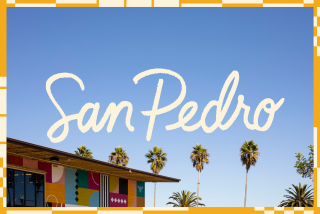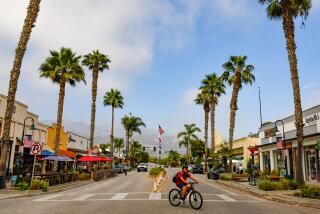Dana Point Planners Cozy Up to Carmel Image
DANA POINT — In 20 years, Dana Point will be part Carmel, part Balboa and part Laguna Beach, with a little La Jolla and Carlsbad added for variety, Carlos Olvera says.
The future visions of Olvera and other Dana Point residents also include a downtown transformed from a haphazard conglomeration of office buildings, fast-food shops and empty lots to a “cozier” urban mix of residences, businesses and pedestrian malls. The city’s Headlands, its most prominent point, is envisioned as a “window to the ocean” providing an unobstructed vista to the Catalina channel.
Olvera, Dana Point’s Planning Commission chairman for the past year, has been helping guide the 3-year-old city through the development of its first-ever General Plan, often described as the blueprint of the city’s future. To do so, he and other planning commissioners and local businessmen recently toured Dana Point’s coastal California cousins.
“We wanted to see what it was about these other cities that made them work, or perhaps not work,” Olvera said. “Maybe if it worked there, we could bring it home to our city.”
If adopted as expected Tuesday, the General Plan will reveal the results of the planning commissioner’s fact-finding travels, as well as 13 months of work put in by city staff and planning consultants.
The nine-part plan may have elements borrowed elsewhere, but the result will be Dana Point’s own identity, city officials say.
“I guess if there is a theme to the General Plan, it’s the desire to try and make Dana Point a city,” said Ed Knight, community development director. “We are trying to create an identity for Dana Point, or at least lay its foundation.”
The General Plan marks the first time the future course of the 6.7-square-mile city has been charted by planners in its entirety. Dana Point, a sleepy community when settled in the early 1900s and the site of substantial growth after World War II, is today a combination of all or parts of the earlier individual communities of Dana Point, Capistrano Beach and Monarch Beach.
If the General Plan is to be successful, it will have to incorporate some of the allure of Carmel and Balboa, Olvera said. Coziness is the word he uses to describe those towns’ friendly feeling that invites visitors to get out of their cars and stay awhile.
“We want to offer the ability to wander in and out of properties like those cities do,” Olvera said.
The General Plan divides the city into parts and applies an individual “broad-brush” plan to each section.
Four of the key sections are:
* The Headlands (119 acres): The most prominent peninsula in South County, the Headlands is the site of one of two world-class resorts planned for the city. A 27-acre hotel and commercial resort and a 47-acre residential project are being planned for the property owners, the M. H. Sherman and Chandis Securities companies.
* Monarch Beach (565 acres): The other major resort site, now being planned by the Monarch Bay Resort Co., a division of Nippon Shinpan Ltd. of Japan. Here, the General Plan also approves 238 homes, a 400-room hotel, a golf club and a beach club, a far cry from the developer’s earlier request to build an 1,100-room hotel, 300,000 square feet of commercial space and 3,200 homes.
* Town Center (69 acres): This is Dana Point’s downtown, an island surrounded by Coast Highway and Del Prado Avenue. The key in this area is to draw in visitors, tourists and locals.
* Doheny Village (150 acres): It is planned to be the city’s only industrial area, but major business and shopping centers are also envisioned. The General Plan also allows room for a transportation center near the site of the old Serra train depot and apartments or condominiums to meet affordable housing demands.
More to Read
Sign up for Essential California
The most important California stories and recommendations in your inbox every morning.
You may occasionally receive promotional content from the Los Angeles Times.










